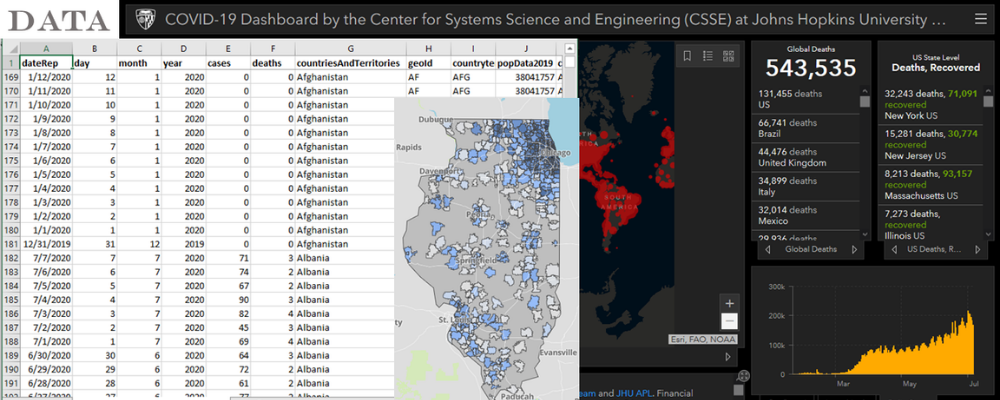As mathematicians and scientists, we embrace data and are adept at reading and understanding data in its various forms. But this is not so for the general public. We recently highlighted an article on how the COVID-19 crisis is made worse in the United States because of math anxiety. Data and statistics about the pandemic can be misused or misinterpreted, mainly due to lack of understanding about the numbers. As teachers of math and science, we have the skills to analyze the data for ourselves and are capable of showing others how to do the same.
Leaders in mathematics education are calling for reforms to focus on data and data analysis rather than computation skills. Jo Boaler and Steven Levitt wrote an opinion piece for the Los Angeles Times calling for changes to mathematical standards to address data science rather than traditional algebra and geometry courses. A recently published book, The Math(s) Fix, by Conrad Wolfram calls for teaching computational thinking rather than calculation. The four-step computational thinking process starts with defining questions that can be answered using data analysis and ends with interpreting the results.
Computational thinking skills using data are critical for the careers of today and tomorrow. With computers being pervasive in our lives, massive amounts of data are generated each time we use a store rewards card, use a search engine, or post to social media. The big questions are not about what this data is or how to store it, but how to use the data and for what purposes. According to the U. S. Bureau of Labor Statistics jobs involving big data, including database administrators and various types of analysts have a higher than average projected job outlook in this decade.
As math and science teachers, we are on the front line of educating about data and how to use it. We are responsible for preparing the students of today into the people of tomorrow who will use data to ask and answer the questions that will impact our lives. So how can we, as teachers, do this?
Questions and More Questions
The first thing is to find topics that our students will find interesting. Our students care about being able to go places and socialize with others but are unable to do so. Our daily lives have been disrupted significantly because of a global pandemic. The news reports are rife with the numbers of cases and numbers of deaths and there is still talk about ‘flattening the curve.’ Yet many of us know very few people who have been infected with the virus.
Because the COVID-19 pandemic impacts your students’ lives directly, they will likely have an interest in it. And I don’t know about you, but I have a lot of questions and our students probably do too. Many reports distill the raw data to seemingly simple numbers. These numbers dictate whether and when we are able to come out of our homes and back into the world. As mathematicians and scientists, we can figure out how these numbers were calculated. But first, we must ask the questions.
Take a moment and brainstorm what questions you have. Then consider what data and mathematical skills you would need to answer that question. We’ll go through a simple example here. My question: How has the death rate in the U.S. changed over time? To answer this question, we would need to know the number of cases and the number of deaths for given periods of time. We would need to have basic computation skills and then be able to display this information in a data table and on a graph. We may then create and interpret best-fit models using more advanced math skills.
Finding the data

Once we have some good questions, we need to find the data that can be used to answer that question. For the example question above: how has the death rate in the U.S. changed over time, we can look at data focused on the United States and reports number of cases and number of deaths by week. Fortunately, the Center for Disease Control and Prevention (CDC) has a COVIDView Weekly Summary, which, as the name implies, is updated weekly and contains the data we need to answer the example question. This summary contains not only death rates, but also hospitalizations, age and race statistics, and information on underlying conditions. One drawback to this Summary is that much of the data is already displayed graphically. So, rather than analyzing raw data, this resource can be used to check students’ abilities to read and interpret graphs.
If you want to have your students analyze raw data, check out the European Centre for Disease Prevention and Control. From this website, you can download a very large Excel spreadsheet listing the number of new cases and number of deaths each day for many countries around the world. The data is somewhat limited in its scope, but this spreadsheet has tens of thousands of rows and is getting larger as it is updated daily.
Many news organizations get their data on the COVID-19 pandemic from the Center for Systems Science and Engineering at Johns Hopkins University. The dashboard fits on a single screen and contains data organized by state and by country. You can click on the arrows to scroll through the number of deaths, number recovered, hospitalizations, and number tested. This data is as close to real-time as you can get with updates at least once a day.
Other news organizations are getting their data from the COVID Tracking Project. This resource, from the same group that publishes The Atlantic, uses volunteers, mostly from local health clinics, to collect and share data. On the Data Download page, you are able to download spreadsheets by state that provides numbers of positive and negative tests, deaths, hospitalizations, how many people on ventilators, and more. You can view some well-created charts and graphics like the number of new cases per one million people on the Charts page.
If you want to look at data on the local level, state departments of health report their own numbers. The Illinois Department of Public Health keeps data and statistics per county and per zip code. Search for your own zip code to see how many people have been tested, how many tested positive, and how many deaths. Age, race, and gender demographics are also reported graphically on the site.
Brief Tutorial on the Spread of Viruses
Coming up with questions and using some of these databases are a good start. But if you are teaching more advanced students and want to get into mathematical models, it helps to understand how viruses, like COVID-19 spread in a population. Viruses are tiny, even by microbial standards, and they cannot be killed because they are not alive by most biology definitions. We can only prevent the spread of the virus to others and treat the symptoms when we get infected. So how do we prevent the spread?

There are three main ways that most infectious diseases, including viruses, are transmitted person-to-person. One is by direct contact with bodily fluids – think of sharing needles, sexually transmitted diseases, and wounds. This is the reason all medical personnel wear protective gloves all the time. The second is by the fecal-oral route. I’ll let that one sink in for a moment. COVID-19 virus has been found in the feces of infected persons and may be spread this way. Some infamous infectious diseases spread via the fecal-oral route are E. coli, Salmonella, and cholera. This is the reason clean water is a necessity and why we wash our hands after using the bathroom! The third is via respiratory droplets.
The air is full of particles that are invisible to the naked eye. Anyone with a pollen allergy knows this first-hand. We don’t see pollen, but we do feel its effects! Respiratory droplets from people are similarly invisible. They come from our mouths and noses when we talk, cough, or sneeze. These droplets contain a myriad of things suspended in liquid, including the COVID-19 virus if one is infected. Other people can pick up these particles by breathing them in, ingesting them, or otherwise having them in contact with mucus membranes, perhaps by touching a particle with our fingers and then rubbing our eyes. COVID-19 is spread via respiratory droplets.
Understanding how COVID-19 spreads helps to explain our current safety measures. If a person is infected, wearing a mask stops most respiratory droplets from coming out. A majority of respiratory droplets fall to the ground within a distance of 6 feet. By staying out of this 6-foot zone, the likelihood of breathing them in is greatly reduced. Most infectious agents gain access to your body through the mouth, nose, and even the eyes. This is why there is a call to not touch your face. Wearing a mask helps not only to block you from breathing in other’s respiratory droplets but it also helps you to remember not to touch these areas of your face. And of course, wash your hands often!
Mathematical Models

Knowing how viruses spread is important because it plays a role in how mathematical models are determined. Decisions to close schools, to implement stay-at-home orders, and to allow for gradual reopening of businesses are based, at least in part, on mathematical models. Each model uses real data to take into account population density, current number of infected individuals, and length of time an infected person can spread the virus to others. Models also make assumptions in terms of susceptibility of becoming ill with the virus, likelihood of travel to other areas, and compliance with guidelines for masks and social distancing.
As you can imagine, the mathematical models can become quite complex. A recent academic article found in Precision Clinical Medicine evaluates various mathematical models that have been used to predict the spread of COVID-19. The authors do a fair job of explaining how the models are calculated and describe various assumptions from each. If you are teaching calculus, I recommend taking a look and consider whether you want to use current available data with some of these models.
The biggest challenge to mathematical modeling and the reason for the variability in models is that the pandemic is ongoing and there is still much we do not know. The data is changing daily and these changes in numbers of infections, number recovered, and compliance with guidelines can affect the results of the models. The second wave of COVID-19 infections as restrictions are relaxed were predicted by many models. And these predictions appear to be coming true.
If you choose to explore mathematical modeling with your students in the fall, they will create different models than what is available now. The data is ever-changing and the data analysis will be happening in real time. The students will become mathematicians - using data and computing answers. They can create the models and use them to make decisions about how we can do things like going to a sporting event or concert while preventing spread of the virus.
Interpreting results by telling the story
The decision-making piece of mathematical models is the critical last piece that we often overlook when we teach math. We ask the questions, we find the data, we analyze the data, now we need to interpret the results and explain them in such a way as to tell a story and compel others to action. This final piece takes math from being a school subject to being a tool that can influence our lives in the real world.
An article from the World Economic Forum describes how the COVID-19 pandemic has brought data-driven storytelling to the forefront of communication. Think about the ‘flattening the curve’ chart. This now iconic image, based upon data and mathematical models, compelled the public to voluntarily comply with stay-at-home orders when the pandemic was beginning. The data alone was not enough. A good story embedded in cultural contexts with a clear message was necessary. The data supported the story and the story provided meaning for the data.
“We are responsible for preparing the students of today into the people of tomorrow who will use data to ask and answer the questions that will impact our lives.”
Likewise, we can have our students consider the story they want to tell with their data before they begin. In the example question: how has the death rate in the U.S. changed over time, the story may be to encourage people to take care of their health to reduce the threat of death by COVID-19 or it may be to reduce anxiety over participating in activities with others. The story could go either way depending on the results of the data analysis. Encourage your students to consider what story they might tell with their question and data analysis that may drive people to action.
The COVID-19 pandemic has brought data and mathematics to the forefront of our daily news. We as math and science teachers can use the pandemic as a catalyst to motivate students to ask questions and engage with data analysis. We can transform the students of today into the public of tomorrow who are capable of engaging with the mathematics that shapes our everyday lives.

Look at some of the data sources provided and devise questions that can be answered by your students. Which of these questions can help you to advance the content that you are teaching?
Author Info: Arlene Vinion Dubiel, Ph.D. spent several years researching infectious diseases before turning her attention to education. While she prefers bacteria to viruses, she knows that all infectious agents function in similar ways. She also knows to eat some dirt once in a while to keep the immune system healthy.







